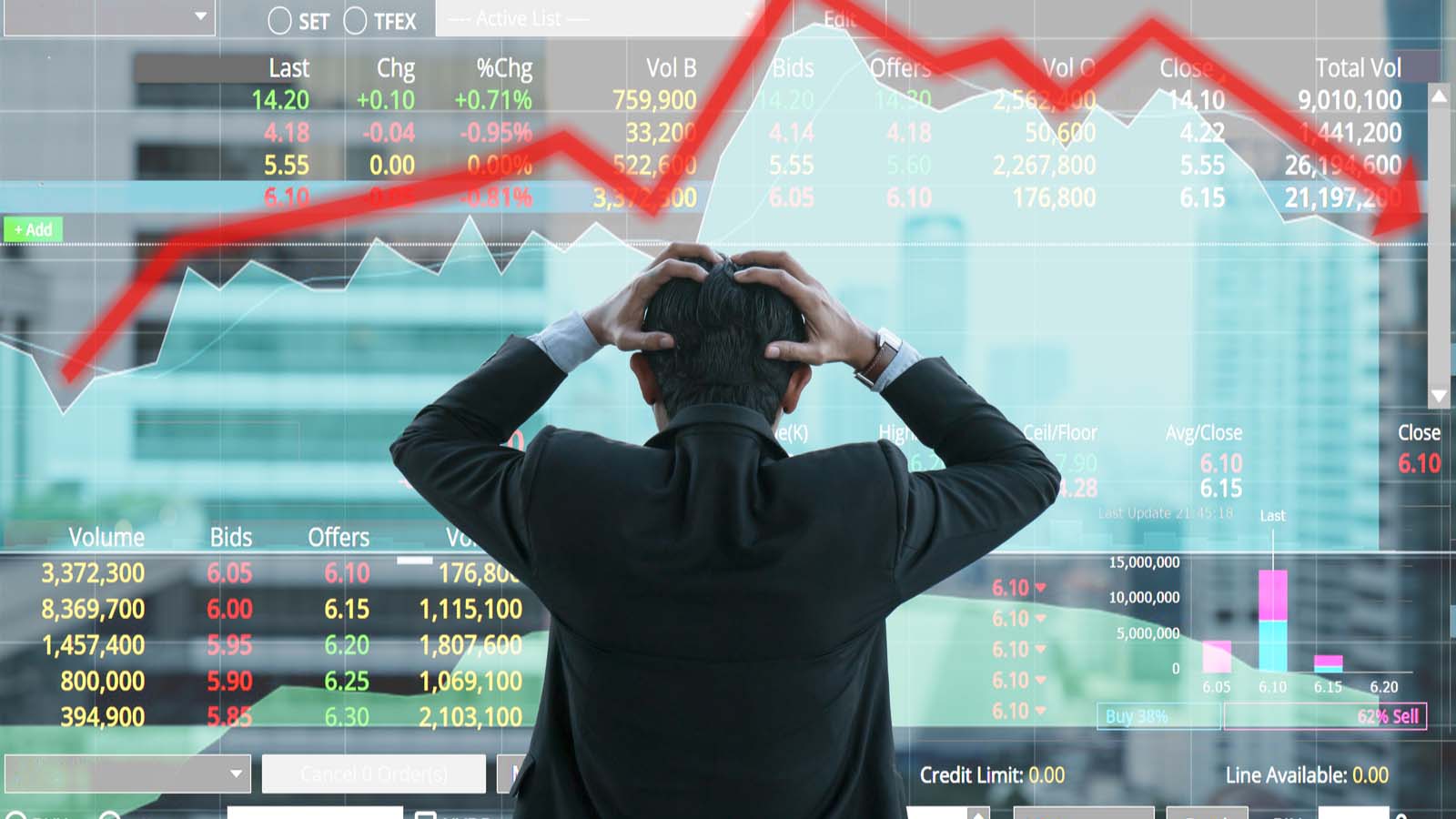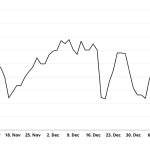
The S&P sits at a critical level … the S&P Equal Weight Index is in the gutter … this is a trader’s market, not a buy-and-hold market … KO continues rebounding … a new blue-chip trade
Let me show you how lopsided this market is…
Yesterday, I reviewed some technical indicators for the S&P, beginning with its 200-day moving average (MA).
For newer Digest readers, the 200-day moving average is a line on a chart showing the average of the prior 200 days’ worth of asset prices.
It’s an important psychological line-in-the-sand for investors and traders. If the S&P is above this level, traders often interpret it as “bullish,” so “buy the dip” is the default mindset.
But when the S&P falls below the 200-day MA, many traders and algorithmic trading programs interpret it as new bearish leadership. So, the default mindset often becomes “sell the rip.”
Given this mental line in the sand, staying above the 200-day MA is paramount – not only for supporting the Q4 rally we all want, but for preventing a potential algo-triggered selloff that compounds upon itself.
As I write Wednesday morning, the S&P appears in danger of losing its 200-day MA. This alone is a big story – we need the S&P to break north or else this ugliness could intensify. Here’s how it looks…

How does this 200-day MA tie into a lopsided market?
We’re getting there.
Remember, the S&P 500 is a “weight averaged” index. In other words, the bigger the company, the more “representation” it has in the index. Given this, when we look at the S&P’s price, we’re not viewing an accurate depiction of how its average stock is performing. We’re getting a skewed conclusion, heavily impacted by the performance of the largest companies in the index.
As you know, these largest companies include the “Magnificent 7” (Alphabet, Amazon, Apple, Meta, Microsoft, Nvidia, Tesla). And these stocks have been named “magnificent” for a reason – they’ve each had great years. As a group, these stocks have returned an average of roughly 90% in 2023.
But what about the average stock in the S&P?
Well, for that analysis, instead of looking at the S&P 500, we’d analyze the “Equal Weight” S&P 500 index. As the name suggests, this gives us the equal representation we’re looking for.
Below, we look at the price action of the S&P Equal Weight Index, along with where it trades relative to its 200-day MA. For context, look once more at the chart above in which the S&P trades right at its 200-day MA.
This is what a lopsided market looks like…

The S&P Equal Weight Index is already more than 7% below its 200-day MA. That’s enormous.
If you’re frustrated by the apparent inconsistency between how the market has performed this year compared with how your portfolio has performed, perhaps here’s your explanation.
How to manage the lopsided market
Two things:
One, as we’ve urged all year, stop viewing the market as one big monolith that rises or falls in unison. See it for what it is – a collection of thousands of different stocks that rise or fall for different reasons on different timeframes.
In other words view is as a “market of stocks” rather than a “stock market.” From this perspective, broad index performance is irrelevant. What matters is the performance of whatever specific stocks you’re in.
Two, find pockets of market strength and capitalize on them. They’re all over the place.
One example we’ve highlighted recently is the selloff in Coca-Cola (KO).
In recent weeks, KO’s stock has been crushed by fears that the weight-loss drug, Ozempic, will kneecap demand for Coca-Cola’s beverages. Between July 27th and October 5th, KO shed 16%.
In our October 9th Digest, we put KO on your radar, highlighting its Relative Strength Index (RSI) and MACD (“moving average convergence/divergence”) indicators, noting they were nearing a greenlight for a rebound trade.
A week ago today, we suggested investors comfortable with the risk could jump into the trade. As we hoped and expected, the rebound is coming along nicely (we’ll show you in a moment). Readers who viewed KO through an opportunistic trading lens are enjoying profits on a stock that is most certainly not going belly up because of a weight-loss drug.
Keep in mind, beyond its sugary drinks, Coca-Cola has an enormous portfolio of brands including Dasani, smartwater, vitaminwater, Topo Chico, BODYARMOR, Powerade, Minute Maid, Simply, innocent, Del Valle, and fairlife. Terrified investors who sold KO due to Ozempic fears seem to have forgotten this.
But as you can see below, other investors’ fear is our advantage when we put on our trader’s hat and keep a cool, measured perspective on market opportunities.

By the way, right now, KO is offering a 3.3% dividend yield. In essence, you’re getting paid to own a rebounding blue-chip that also happens to be one of the world’s most beloved companies.
Another rebound play happening before our eyes
Verizon is one of the world’s greatest telecom stocks.
It has also gotten crushed over the last two years as interest rates have surged. You see, Verizon and other telecoms have heavy debt loads. So, as the Fed has hiked rates, investors have abandoned Verizon expecting that the company will have to refinance some of its debt in this oppressive environment and that will result in lower profits.
Also, since Verizon pays a healthy dividend, many investors feared that management might cut the dividend due to expensive refinancing costs that eat into free cash flow.
Below, we look at Verizon from late-March through last week. We’re going to analyze it using the same indicators we applied to KO – the RSI and MACD.
Take a look, then we’ll offer our perspective.
Do you see a trade brewing?

First, as to VZ’s price itself, it was just month after month of pain.
But after this type of relentless beating, sometimes all it takes for a bounce is the slightest spark of good news. We’ll return to this idea in a moment.
Meanwhile, as you can see above, the RSI level had fallen all the way to 30 at the beginning of the month. That’s heavily oversold. The RSI then began edging higher, even though the stock continued moving lower. Many times, this is suggestive of brewing strength.
On the MACD chart, we see the MACD line stop dropping in early-October. It begins trading sideways, and then has a bullish crossover with its signal line. Many traders interpret this as a green light for a bullish trade.
For traders, these indicators are signaling “on your mark, get set…”.
Now, circling back to the “slightest spark of good news” …
Yesterday, Verizon reported earnings. While both earnings per share and revenues topped expectations, the real story was VZ’s free cash flow. Remember, investors have been worried that interest rates might hurt VZ’s available cash to continue paying its dividend.
Here’s The Wall Street Journal:
(Verizon) forecast free cash flow above $18 billion, a $1 billion increase from its prior guidance. Investors will welcome the extra cash, which Verizon has been using to fund its dividend, pay for capital expenditures and whittle down debt.
And here’s what a spark of good news can do to a stock that’s been beaten down, while its RSI and MACD indicators are suggesting growing bullishness…

I’ll point out that even after yesterday’s 9% one-day jump, Verizon still offers a dividend yield of 7.9% today.
And for those of you wondering about whether the stock can continue climbing, here’s some longer-term perspective…

Now, Verizon still faces a heavy debt load. But if you caught our Digest yesterday, both Eric Fry and Luke Lango believe rates have peaked or nearly peaked. If so, then falling rates will ease refinancing pressures in the quarters to come. And that means a nice tailwind lifting the stock out of oversold conditions…while you enjoy a 7.9% dividend yield.
By the way, Verizon’s price-to-earnings ratio (PE)?
6.76 – which is less than half its 10-year average of 12.52, and miles beneath the S&P’s PE of 24.
Coming full circle, this is a wildly lopsided market with the average S&P stock having taken a beating over the last three months
But as we’ve tried to point out today, forget about “average.”
This is a market for traders and stock-pickers. Oversold opportunities are all over the place. Sure, not all oversold stocks will zoom higher – some will continue falling. That’s why it’s critical to mind your stop-losses. But this market has plenty of firepower in it if you know where to look.
One last example before we sign off…
Two weeks ago, legendary investor Louis Navellier introduced his new trading service – AI Advantage.
It’s a cutting-edge AI system that predicts where fundamentally superior stocks will be trading 21 trading days into the future with 82% accuracy.
The goal is short-term trading profits. Get in, grab, say, 5% – 10% or so, and get out. When you do this repeatedly, you “stack” your returns, snowballing them over time with less exposure to long-term duration risk.
Well, a quick word of congrats to Louis’ subscribers who’ve already locked in their first AI Advantage trading.
From Louis to his subscribers last week:
We closed our position in TETRA Technologies, Inc. (TTI) on Tuesday for a 9.5% gain in just five trading days.
The stock popped more than 3% in early trading, boosting it above Predictive Alpha’s $6.50 target price. I recommended that we sell TTI at $6.50 or better.
Congrats to all the AI Advantage subscribers. We expect this is the first of many such short-term winners to come.
Bottom line: It’s a trader’s market today. Keep your eyes open. There are opportunities all over the place.
We’ll help you find them here in the Digest.
Have a good evening,
Jeff Remsburg




